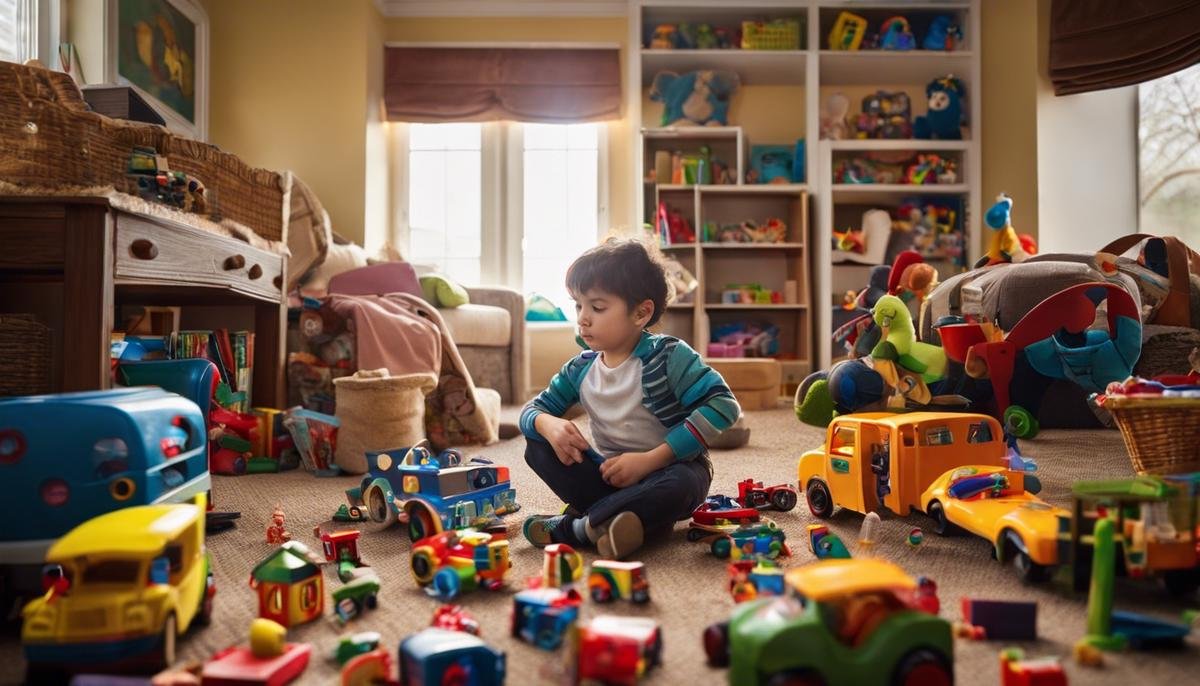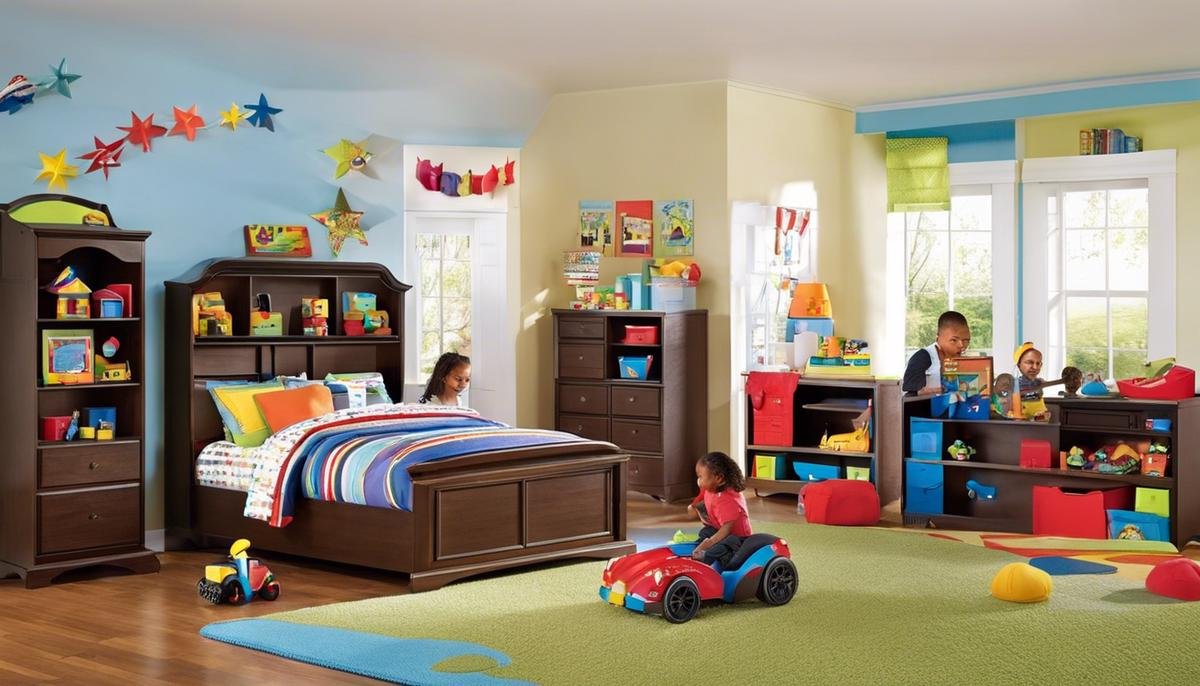
Autism’s myriad manifestations often pose unique challenges to those caring for autistic children, one of the notable behaviors being toy hoarding. Autism impacts how a child perceives the world and influences their behaviors, including those related to play and their belongings. This understanding is fundamental to approaching the topic of toy hoarding, a common yet nuanced phenomenon among autistic children. In the sections that unfold, we delve into the psychology behind this behavior, its impact on the child and their family, the principles of behavior management, practical strategies for modifying such behaviors, and when to seek professional intervention.
Understanding Toy Hoarding in Autistic Children
Understanding Toy Hoarding in Autistic Children: A Deeper Dive into Triggers and Significance
There’s something incredibly heartwarming about seeing a child embrace their favorite toy. However, have we ever paused and pondered what it means when they start accumulating more and more toys, especially in children with autism? It could merely be a fondness for playthings or something much more complex, like an aspect of autism spectrum disorder behavior. It’s crucial to put it in the correct perspective, encourage the right behavior, and ensure the child experiences a healthy and happy environment.
Hoarding toys can often be linked to the autistic child’s innate sense of comfort, control, and reassurance. Let’s delve a bit deeper and seek to comprehend why some children on the autism spectrum exhibit hoarding behavior.
For many autistic children, toys may serve as more than just playthings. They can provide a measure of security and emotional stability. Often, these children find solace and refuge in familiar objects and environments. Hence, amassing a large number of their favored toys could be an attempt to create a familiar and secure environment. It’s their way of building a safe haven, their little world.
Toys can also offer a sense of control to children with autism. With their toys around, they know exactly what to expect. There’s no upheaval, no surprises, just predictable, comforting routine. This sense of control can be tremendously soothing to a child on the spectrum, as change and unpredictability can often lead to distress and anxiety.
Additionally, there are instances where hoarding behavior stems from the need for sensory stimulation. Children on the autism spectrum may find great joy in the feel, the texture, and the colors of their toys. They might be inclined to collect a large number of these objects to stimulate their senses continuously.
Yet, it’s imperative to remember that each child on the autism spectrum has a unique personality and will exhibit different behaviors. While some may hoard toys, others may not. Just as with any other behavior, it’s important to approach this with patience, understanding, and empathy.
So, what does this signify? It’s not just a child piling up toys for the sake of it. Instead, it’s an outward manifestation of inward feelings that the child might not be able to express otherwise. It’s a call for us as parents and caregivers to comprehend their unique needs better and build on that understanding to create a more accommodating environment.
While it’s fine to let your child hoard some toys for the sake of comfort, it’s also essential to encourage a healthy interaction with their environment. Where appropriate, gently and gradually introduce changes and new elements, promoting adaptability and resilience.
Remember, the ultimate aim is not to discourage hoarding completely but to ensure that it doesn’t hinder the child’s growth, learning, or interaction with others. This understanding and the resultant actions could reinforce their sense of security and comfort, consequently enhancing their quality of life.
In the journey of parenthood, especially while raising a child on the autism spectrum, no two days are alike. There’s always something new to learn, something new to discover. And as we navigate this journey together, the bonds we build, the love we share, and the joy that manifests, fills our hearts and homes with unfathomable warmth and happiness. After all, isn’t that what family life is all about?

The Impact of Hoarding on the Child and the Family
Title: Hoarding’s Impact: Beyond Toys and the Autism Spectrum
Making a happy and healthy home is much like building a puzzle. Each piece works in harmony to create a beautiful, wholesome picture. Occasionally, a systematic anomaly, like hoarding, can disturb this equilibrium.
For families with children on the autism spectrum, toy hoarding becomes a part of their reality. As parents, recognizing the impacts of hoarding, or collecting excessively, can offer valuable insights into a child’s perspective and shed light on how this influences family dynamics.
The home is a cornerstone of family life, providing a safe and nurturing environment for all its members. However, when hoarding behavior begins building towers of toys, it can cause disruptions. The physical environment transforms, and navigating through amassed collections can contribute to stress and anxiety. Clutter evokes a sense of chaos and jeopardizes the tranquility family spaces should hold.
Moreover, it’s not just about the toys. The behavior through which these toys are obtained, kept, and valued, plays a significant role in the social development of any child. General interaction becomes tricky when shared spaces become battlegrounds for negotiating over toys. Visits to friends, playgrounds, and schools can be challenging if the child becomes fixated on acquiring more items, compromising their social skills development.
The attachment to objects also has repercussions on how children value relationships. They may develop a distorted perception of possession and sharing, which can lead to social isolation at the expense of building human connections. This degree of possessiveness can be daunting to siblings who, instead of sharing toys and activities, are often pushed aside, causing feelings of alienation and resentment.
Furthermore, hoarding can create family tension, particularly if different caregivers perceive this behavior differently. The discrepancy in strategies to cope with the situation can lead to conflicts among parents, grandparents, or other caregivers. Legacy objects, or those deemed sentimental by other family members, might be unintentionally caught up in the child’s collection, leading to further emotional distress.
Addressing hoarding behaviors echoed in collecting toys excessively can fundamentally impact a child’s cognitive, social, and emotional well-being. It requires patience, out-of-the-box thinking, and professional support. Parents might need to advocate for their children, representing their needs and challenges to educators, professionals, and extended family members to ensure comprehension and cooperation in managing the situation.
Weaving through this complex web as parents can be overwhelming, rocky, and challenging. These difficulties, however, are not without rewards. The experiences facilitate the formation of robust family relationships, built on understanding, respect, and love for one another’s unique attributes, strengthening the family’s bond.
Remember, every puzzle takes time and effort to complete. Approach it piece by piece, with love and patience, and before you know it, the picture will begin to form—a beautiful representation of family life, enriched by its journey and diversity. These tests of family resilience and adaptability not only help create a comforting environment for children on the spectrum but also foster a nurturing space for the entire family to flourish.

Basic Principles of Behavior Management
Effectively Managing Autism-Related Toy Hoarding: Key Principles
As we navigate the unique journey of parenting an autistic child, we may come across certain unexpected behavioral challenges. One such challenge, toy hoarding, greatly impacts individuals on the autism spectrum. This behavior not only seems disruptive but can also incur stress but also affect the social development of the child.
The Impact of Toy Hoarding
Understanding the subtle nuances that come with autistic behavior means acknowledging the impacts of hoarding. This is crucial, as a home’s natural balance can be significantly disrupted with the accumulation of toys. The difficulty in navigating through cluttered spaces may, in turn, cause stress and anxiety for the autistic child, as well as other family members.
In addition, toy hoarding can drastically influence social development and interaction. Our children may develop a distorted perception of possession and sharing. This may lead to social isolation, where they alienate themselves from others, and possibly harbor resentment towards siblings due to their hoarding behavior.
Addressing Hoarding Behavior for the Child’s Well-Being
As parents, we strive for harmony within the household. Family tension and conflicts may arise due to differing coping strategies for handling hoarding. This is particularly true when sentimental, cherished possessions unintentionally become part of our children’s toy collections.
However, it’s crucial to remember that addressing these behaviors is central to our child’s well-being. Advocating for our kid’s challenges and unique needs with educators and professionals forms a strong basis for encouraging growth, understanding, and a more positive emotional landscape.
The Family’s Role in Managing Hoarding Behaviors
Managing hoarding behaviors as parents may feel daunting, but through patience, love, and understanding, these challenges can be overcome. Fostering strong family relationships is built on respect for these behaviors, rather than resentment. The diversity of family life is integral to overcoming these challenges—instead of viewing these behaviors as a barrier, begin to see them as an essential part of the tapestry that makes up your unique family.
Finally, creating a nurturing space where the entire family can flourish is essential. Embrace the journey, with all of its challenges and intricacies, and begin to transform your household into an empowering space that bolsters resilience. Managing hoarding behaviors doesn’t happen overnight, but with consistent effort, love, and understanding, we can provide our children not just a room full of toys, but a home full of support, stability, and love.

Practical Strategies for Managing Hoarding Behavior
The management of hoarding behaviors in autistic children is often a hurdle many parents face. While toys play a crucial role in the development of children with Autism Spectrum Disorder (ASD), excessive collection can have its drawbacks. It’s important to note that this behavior isn’t exclusive to children with autism, but managing it can present unique challenges for both the child and the family.
Hoarding behavior not only takes up physical space but can also cause stress and anxiety for the child when they have to navigate through cluttered spaces. Moreover, these behaviors can disrupt typical household activities and cause tension, particularly when the collected items include objects of sentimental value to other family members. But fear not, as there’s a variety of strategies families can employ to manage this behavior.
The first step is always acknowledging and addressing these behaviors as part of the child’s unique needs and challenges. It’s crucial to involve educators and professionals in this process, as they can present valuable insights and strategies. Schooling environments can often inadvertently reinforce hoarding tendencies, so ensuring educators understand and respect the child’s needs is key.
Building strong family relationships through understanding and respect is also essential in managing hoarding behaviors. Active communication and the willingness to understand the child’s perspective can help alleviate feelings of alienation and resentment within the household. Through this, families can navigate through the challenges of hoarding behaviors.
Remember, patience and love are integral in this journey. Take time to celebrate the small victories and progress as these moments contribute to the resilience of not just the child, but the entire family as well. The diversity of family life looks different in every home, but what remains consistent is the ability to overcome challenges together.
Creating a nurturing space for the family involves transforming the household into an empowering environment. By adjusting the layout of the home and designating areas for collected items, families can balance the child’s needs with the practical functioning of the home. Additionally, rotating toys can provide opportunities for the child to adapt to changes in a controlled and safe manner.
Overcoming hoarding behaviors is often a gradual process. It involves fostering understanding, practicing patience, and employing practical strategies. Though the journey may seem overwhelming at first, remember that every step you take is in the best interest of your child’s well-being and the harmony of your family. Through these trials, families can potentially create environments where every member flourishes, not despite the challenges, but often because of them.
In the end, managing hoarding behaviors is one aspect of the colorful journey of raising a child with autism. Every situation, every challenge, and every win contributes towards creating an environment where love, understanding, and resilience thrive. These experiences enrich the family bond and aid in navigating the truly unique and rewarding journey of parenthood.

Professional Help and Resources
As we continue our discussion, it becomes increasingly apparent that navigating hoarding behavior in children with autism spectrum disorder involves a family-centric approach. The stirred emotions, the rearranged living spaces, even the familial conversations that result are all integral to the family dynamic when guiding an autistic child through hoarding tendencies.
Continual disruptions caused by toy hoarding can lead to a home environment that might seem chaotically filled to the brim. But rather than viewing these instances as hurdles, it can be more helpful to see each as an opportunity to learn the art of organizing and maintaining a balanced environment.
Undoubtedly, navigating through these cluttered spaces can bring on feelings of stress and anxiety for the child and family members. Hence, it’s crucial to slowly enable the child to accept changes while minimizing any distress. Remember, every child responds to strategies differently, so, what works for one may not work for another. It could take some time to find the right solution, but the effort is deeply worthwhile.
Hoarding behavior, particularly in the case of toy collection, can greatly influence a child’s social development and interaction. A distorted perception of possession and sharing can often lead to social isolation. Balancing the child’s need to collect with educating them about the importance of sharing can be a delicate task, but it’s an important aspect of building their social skills.
Instances might arise where, owing to hoarding behavior, a child might experience alienation or even resentment from siblings. NUrturing open communication amongst siblings, and understanding and empathy towards the child’s unique needs can help alleviate many of these issues.
While every family member might cope differently with hoarding behavior, this can sometimes cause tension and conflicts. A unified approach based on understanding and respect can help in managing these challenges while fostering a sense of unity.
There’s something else that lends urgency to addressing hoarding behavior: the unintentional inclusion of other family members’ sentimental objects in the child’s collections. It’s important to discuss this with the child, providing them a sense of why each item holds sentimental value to the original possessor, helping them to understand boundaries and respect for others’ belongings.
Addressing hoarding behavior is integral to the child’s well-being. Every stakeholder in the child’s life — be it parents, educators, or professionals — plays a crucial role in advocating for the child’s unique needs. Creating a culture of understanding, patience, love, and acceptance can be a big help in addressing and managing hoarding behaviors.
Coming up with strategies to manage hoarding behavior isn’t a destination but a journey. It might include professional guidance, some trial and error, and a good amount of patience. But at the end of the day, the goal should always be to create a happy, nurturing space for both your child and the family.
Through patience and love, every challenge can be turned into an opportunity to foster strong family relationships and understanding. Every small breakthrough is a testament to familial strength. Let’s view these challenges not as roadblocks, but as opportunities that serve to enhance the family’s resilience and cohesiveness.
In embracing this journey, we learn to transform our households into empowering spaces for resilience and support. Let’s consider our homes a fertile ground for love, acceptance, and support, where each member has their unique place, and everyone thrives.
No doubt, the challenges of managing hoarding behaviors in autistic children can seem daunting. But they can also pave the way for incredible growth, resilience, and meaningful connections within the family. It’s the beautiful, rewarding, and unique journey of raising a child with autism, where we learn just as much as we teach, love just as much as we are loved, and grow alongside our children.

Managing toy hoarding behavior is a journey that requires patience, understanding, and the implementation of appropriate strategies. It’s not just about decluttering; it’s about encouraging sharing, fostering an organized space, and nurturing a positive approach to play in an autistic child. Remember, it is okay to seek help! Professionals in the field, with their knowledge and expertise, can guide you effectively in this endeavor. Furthermore, a plethora of resources exist to support parents and caregivers in their quest to provide the best care possible. Harnessing these tools and strategies will not only help manage hoarding behaviors but also aid in creating a happier, more balanced life for the child and the family.




